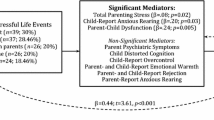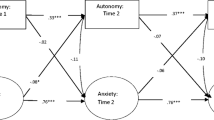Abstract
This study examined child anxiety sensitivity and family environment as mediators of the relationship between (1) parent psychopathology and anxiety sensitivity and (2) child anxiety in a community sample of 157 youths aged 7–18 years. Parents completed measures of anxiety sensitivity, psychopathology, and family environment. Youths completed measures of anxiety sensitivity and anxiety. One structural equation model was tested with child anxiety sensitivity as a mediator of (1) parent psychopathology and parent anxiety sensitivity and (2) child anxiety. Mediation was found with respect to parent psychopathology but not anxiety sensitivity. A second structural equation model was tested with family environment (conflict and control) as a mediator of (1) parent psychopathology and parent anxiety sensitivity and (2) child anxiety. Mediation was found with respect to parent psychopathology and anxiety sensitivity. Possible explanations for these pathways are discussed, including information transmission from parents to children, modeling anxiety-based reactions, temperament, and isolation of children from anxiety-provoking situations.


Similar content being viewed by others
References
Alnaes, R., & Torgersen, S. (1990). Parental representation in patients with major depression, anxiety disorder and mixed conditions. Acta Psychiatrica Scandanavia, 80, 518–522.
Austin, A. A., & Chorpita, B. F. (2004). Temperament, anxiety, and depression: Comparisons across five ethnic groups of children. Journal of Clinical Child and Adolescent Psychology, 33, 216–226.
Barrett, P. M., Rapee, R. M., Dadds, M. R., & Ryan, S. (1996). Family enhancement of cognitive style in anxious and aggressive children. Journal of Abnormal Child Psychology, 24, 187–203.
Beidel, D., & Turner, S. (1997). At risk for anxiety: I. Psychopathology in the offspring of anxious parents. Journal of the American Academy of Child and Adolescent Psychiatry, 36, 918–924.
Bentler, P. M., & Wu, E. J. C. (2005). EQS 6.1 for Windows. Encino, CA: Multivariate Software.
Biederman, J., Faraone, S. V., Hirshfeld-Becker, D. R., Friedman, D., Robin, J. A., & Rosenbaum, J. F. (2001). Patterns of psychopathology and dysfunction in high-risk children of parents with panic disorder and major depression. American Journal of Psychiatry, 158, 49–57.
Blais, M. A., Otto, M. W., Zucker, B. G., McNally, R. J., Schmidt, N. B., Fava, M., et al. (2001). The Anxiety Sensitivity Index: Item analysis and suggestions for refinement. Journal of Personality Assessment, 77, 272–294.
Bogels, S. M., van Oosten, A., Muris, P., & Smulders, D. (2001). Familial correlates of social anxiety in children and adolescents. Behaviour Research and Therapy, 39, 273–287.
Bruch, M. A., Heimberg, R. G., Berger, P., & Collins, T. M. (1989). Social phobia and perceptions of early parental and personal characteristics. Anxiety Research, 2, 57–65.
Caster, J. B., Inderbitzen, H. M., & Hope, D. (1999). Relationship between youth and parent perceptions of family environment and social anxiety. Journal of Anxiety Disorders, 13, 237–251.
Chiu, I., & Brennan, M. (1990). The effectiveness of some techniques for improving mail survey response rates: A meta-analysis. Marketing Bulletin, 1, 13–18.
Chorpita, B. F., Albano, A. M., & Barlow, D. H. (1996). Cognitive processing in children: Relationship to anxiety and family influences. Journal of Clinical Child Psychology, 25, 170–176.
Chorpita, B. F., & Lilienfeld, S. O. (1999). Clinical assessment of anxiety sensitivity in children and adolescents: Where do we go from here? Psychological Assessment, 11, 212–224.
Cobham, V. E., Dadds, M. R., & Spence, S. H. (1998). The role of parental anxiety in the treatment of childhood anxiety. Journal of Consulting and Clinical Psychology, 66, 893–905.
Dadds, M. R., Barrett, P. M., Rapee, R. M., & Ryan, S. (1996). Family process and child anxiety and aggression: An observational analysis. Journal of Abnormal Child Psychology, 24, 715–734.
Dadds, M. R., Davey, G. C. L., & Field, A. P. (2001). Developmental aspects of conditioning processes in anxiety disorders. In M. W. Vasey, & M. R. Dadds (Eds.), The developmental psychopathology of anxiety (pp. 205–230). New York: Oxford University Press.
Derogatis, L. R. (1994). SCL-90-R: Administration, scoring, and procedures manual. Minneapolis, MN: National Computer Systems.
DiLalla, L. F., Kagan, J., & Reznick, J. S. (1994). Genetic etiology of behavioral inhibition among 2-year-old children. Infant Behavior and Development, 17, 405–412.
East, A. J., Berman, M. E., & Stroppelbein, L. (2006). Familial association of anxiety sensitivity and psychopathology. Depression and Anxiety, 0, 1–4.
Eley, T. C., & Gregory, A. M. (2004). Behavioral genetics. In T. L. Morris, & J. S. March (Eds.), Anxiety disorders in children and adolescents (2nd ed.) (pp. 71–97). New York: Guilford.
Holmbeck, G. N. (1997). Toward terminological, conceptual, and statistical clarity in the study of mediators and moderators: Examples from the child-clinical and pediatric psychology literatures. Journal of Consulting and Clinical Psychology, 65, 599–610.
Kagan, J. (2001). Temperamental contributions to affective and behavioral profiles in childhood. In S. G. Hofmann, & P. M. DiBartolo (Eds.), From social anxiety to social phobia: Multiple perspectives (pp. 216–234). Needham Heights, MA: Allyn and Bacon.
Kashdan, T. B., & Herbert, J. D. (2001). Social anxiety disorder in childhood and adolescence: Current status and future directions. Clinical Child and Family Psychology Review, 4, 37–61.
Kearney, C. A. (2001). School refusal behavior in youth: A functional approach to assessment and treatment. Washington, DC: American Psychological Association.
Kearney, C. A. (2005). Social anxiety and social phobia in youth: Characteristics, assessment, and psychological treatment. New York: Springer.
Kearney, C. A., & Silverman, W. K. (1995). Family environment of youngsters with school refusal behavior: A synopsis with implications for assessment and treatment. American Journal of Family Therapy, 23, 59–72.
Kendler, K. S., Karkowski, L. M., & Prescott, C. A. (1999). Fears and phobias: Reliability and heritability. Psychological Medicine, 29, 539–553.
Kline, R. B. (2005). Principles and practice of structural equation modeling (2nd ed.). New York: Guilford.
Laraia, M. T., Stuart, G. W., Frye, L. H., Lydiard, R. B., & Ballenger, J. C. (1994). Childhood environment of women having panic disorder with agoraphobia. Journal of Anxiety Disorders, 8, 1–17.
Lindhout, I. E., Boer, F., Markus, M. T., Hoogendijk, T. H. G., Maingay, R., & Borst, S. R. (2003). Sibling relationships of anxiety disordered children—a research note. Journal of Anxiety Disorders, 17, 593–601.
Mannuzza, S., Klein, R. G., Moulton, J. L., Scarfone, N., Malloy, P., Vosburg, S. K., et al. (2002). Anxiety sensitivity among children of parents with anxiety disorders: A controlled high-risk study. Journal of Anxiety Disorders, 16, 135–148.
March, J. S., Parker, J. D. A., Sullivan, K., Stallings, P., & Conners, C. K. (1997). The Multidimensional Anxiety Scale for Children (MASC): Factor structure, reliability, and validity. Journal of the American Academy of Child and Adolescent Psychiatry, 36, 554–565.
March, J. S., Sullivan, K., & Parker, J. (1999). Test–retest reliability of the Multidimensional Anxiety Scale for Children. Journal of Anxiety Disorders, 13, 349–358.
Merikangas, K. R., Avenevoli, S., Dierker, L., & Grillon, C. (1999). Vulnerability factors among children at risk for anxiety disorders. Biological Psychiatry, 46, 1523–1535.
Moos, R. H., & Moos, B. S. (1986). Family environment scale manual (2nd ed.). Palo Alto, CA: Consulting Psychologists Press.
Morris, T. L., & March, J. S. (2004). Anxiety disorders in children and adolescents (2nd ed.). New York: Guilford.
Muris, P., & Merckelbach, H. (1998). Perceived parental rearing behaviour and anxiety disorders symptoms in normal children. Personality and Individual Differences, 25, 1199–1206.
Ollendick, T. H., & March, J. S. (2004). Phobic and anxiety disorders in children and adolescents: A clinician’s guide to effective psychosocial and pharmacological interventions. New York: Oxford.
Peleg-Popko, O., & Dar, R. (2001). Marital quality, family patterns, and children’s fears and social anxiety. Contemporary Family Therapy, 23, 465–487.
Rapee, R. M. (1997). Potential role of childrearing practices in the development of anxiety and depression. Clinical Psychology Review, 17, 47–67.
Reiss, S. (1987). Theoretical perspectives on the fear of anxiety. Clinical Psychology Review, 7, 585–596.
Reiss, S. (1991). Expectancy theory of fear, anxiety, and panic. Clinical Psychology Review, 11, 141–153.
Reiss, S., & McNally, R. J. (1985). Expectancy model of fear. In S. Reiss, & R. R. Bootzin (Eds.), Theoretical issues in behavior therapy (pp. 107–121). New York: Academic.
Reiss, S., Peterson, R. A., Gursky, D. M., & McNally, R. J. (1986). Anxiety sensitivity, anxiety frequency, and the prediction of fearfulness. Behaviour Research and Therapy, 24, 1–8.
Rubin, K. H., & Mills, R. S. L. (1990). Maternal beliefs about adaptive and maladaptive social behaviors in normal, aggressive, and withdrawn preschoolers. Journal of Abnormal Child Psychology, 18, 419–435.
Scher, C. D., & Stein, M. B. (2003). Developmental antecedents of anxiety sensitivity. Journal of Anxiety Disorders, 17, 253–269.
Silverman, W. K., Fleisig, W., Rabian, B., & Peterson, R. A. (1991). Childhood anxiety sensitivity index. Journal of Clinical Child Psychology, 20, 162–168.
Silverman, W. K., Goedhart, A. W., Barrett, P., & Turner, C. (2003). The facets of anxiety sensitivity represented in the Childhood Anxiety Sensitivity Index: Confirmatory analyses of factor models from past studies. Journal of Abnormal Psychology, 112, 364–374.
Siqueland, L., Kendall, P. C., & Steinberg, L. (1996). Anxiety in children: Perceived family environments and observed family interaction. Journal of Clinical Child Psychology, 25, 225–237.
Stein, M. B., Chartier, M. J., Lizak, M. V., & Jang, K. L. (2001). Familial aggregation of anxiety-related quantitative traits in generalized social phobia: Clues to understanding “disorder” heritability? American Journal of Medical Genetics, 105, 79–83.
Stein, M. B., Jang, K. L., & Livesley, W. J. (1999). Heritability of anxiety sensitivity: A twin study. American Journal of Psychiatry, 156, 246–251.
Stevens, J. (1996). Applied multivariate statistics for the social sciences (3rd ed.). Hillsdale, NJ: Lawrence Erlbaum.
Tearnan, B. H., & Telch, M. J. (1988). Etiology of agoraphobia: An investigation of perceived childhood and parental factors. Phobia Practice and Research Journal, 1, 13–24.
Tsao, J. C. I., Lu, Q., Myers, C. D., Kim, S. C., Turk, N., & Zeltzer, L. K. (2005a). Parent and child anxiety sensitivity: Relationship to children’s experimental pain responsivity. Journal of Pain, 7, 319–326.
Tsao, J. C. I., Myers, C. D., Craske, M. G., Bursch, B., Kim, S. C., & Zeltzer, L. K. (2005b). Parent and child anxiety sensitivity: Relationship in a nonclinical sample. Journal of Psychopathology and Behavioral Assessment, 27, 259–268.
Turner, S., Beidel, D., & Costello, A. (1987). Psychopathology in the offspring of anxiety disorders patients. Journal of Consulting and Clinical Psychology, 55, 229–235.
Unnewehr, S., Schneider, S., Margraf, J., Jenkins, M., & Florin, I. (1996). Exposure to internal and external stimuli: Reactions in children of patients with panic disorder or animal phobia. Journal of Anxiety Disorders, 10, 489–508.
van Beek, N., Perna, G., Schruers, K., Muris, P., & Griez, E. (2005). Anxiety sensitivity in children of panic disorder patients. Child Psychiatry and Human Development, 35, 315–324.
Vasey, M. W., & Dadds, M. R. (2001). An introduction to the developmental psychopathology of anxiety. In M. W. Vasey, & M. R. Dadds (Eds.), The developmental psychopathology of anxiety (pp. 3–42). New York: Oxford.
Warner, V., Mufson, L., & Weissman, M. (1995). Offspring at high risk for depression and anxiety: Mechanisms of psychiatric disorder. Journal of the American Academy of Child and Adolescent Psychiatry, 34, 786–797.
Woodruff-Borden, J., Morrow, C., Bourland, S., & Cambron, S. (2002). The behavior of anxious parents: Examining mechanisms of transmission of anxiety from parent to child. Journal of Clinical Child and Adolescent Psychology, 31, 364–374.
Author information
Authors and Affiliations
Corresponding author
Rights and permissions
About this article
Cite this article
Drake, K.L., Kearney, C.A. Child Anxiety Sensitivity and Family Environment as Mediators of the Relationship between Parent Psychopathology, Parent Anxiety Sensitivity, and Child Anxiety. J Psychopathol Behav Assess 30, 79–86 (2008). https://doi.org/10.1007/s10862-007-9055-z
Published:
Issue Date:
DOI: https://doi.org/10.1007/s10862-007-9055-z




